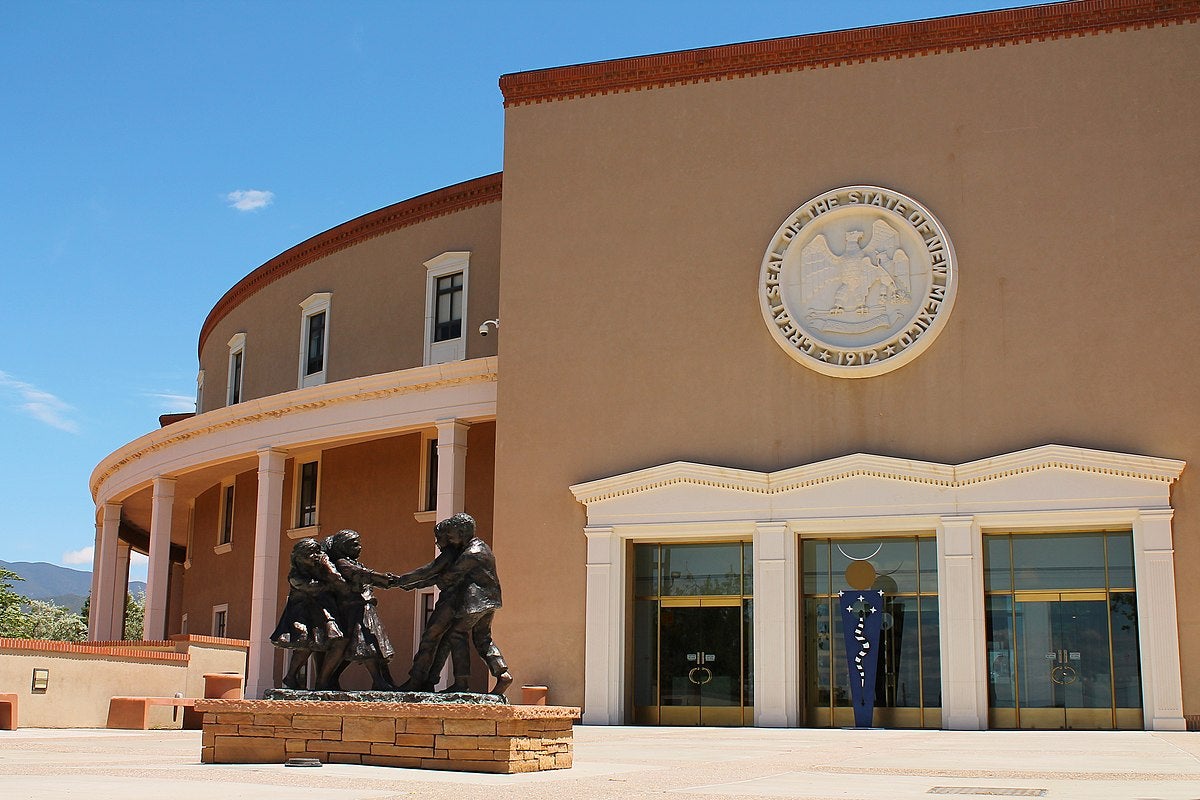
As another legislative session ends, how does New Mexico regain climate leadership?
With each passing year, communities across New Mexico feel the mounting and undeniable pressures from climate change. At times last year, nearly three-fourths of the state was experiencing severe drought. The largest wildfire in the state’s recorded history ripped through New Mexico communities. And mountain snowpack, even in snowy winters, produces less and less water for people and wildlife.
New Mexicans can see clearly how fundamental aspects of their culture and identity are threatened — and want their state leaders to act.
Despite committing to “codifying our zero-emissions goal in state statute” and to pursuing initiatives to meet those goals during her 2023 State of the State, Governor Michelle Lujan Grisham failed to follow through this legislative session when she walked away from comprehensive climate legislation that would have required significant cuts in pollution and ensured a just transition to a clean energy future. Unfortunately, after failing to support legislation that would have paved the way for the regulations necessary to achieve the state’s climate targets, the Governor also opposed additional incentives to help accelerate the state’s clean energy transition as well — vetoing five key clean energy tax incentives.
All of this has occurred under the backdrop of the UN Intergovernmental Panel on Climate Change releasing another report that underscores the dire need for rapid, deep cuts in global emissions to curb the worst climate impacts.
The clock is ticking for meaningful action this decade, and New Mexico can’t afford to keep delaying. Governor Lujan Grisham and legislative leaders need to prioritize climate action with the urgency it deserves by recommitting to 1) utilize existing authority to directly regulate carbon pollution from all of the state’s major sources and sectors, 2) adopt legislation that requires NM to cut climate pollution in half by the end of the decade and achieve net-zero emissions by mid-century, and 3) ensure a just transition for communities as the state shifts to a clean energy economy.
The Challenge
Governor Michelle Lujan Grisham’s early action during her first term set high expectations for her administration and the state of New Mexico as a national leader on climate policy. During her first months as governor four years ago, she signed an executive order directing state agencies to address climate change, signed the Energy Transition Act into law establishing a renewable electricity standard, and initiated the state’s first rules to reduce methane waste from the oil and gas industry.
In addition to the commitments made by Gov. Lujan Grisham to reduce emissions by 45% by 2030, she has subsequently committed to achieve net-zero emissions by 2050 and has supported bills in the legislature that would establish a 50% reduction requirement by 2030, 75% requirement by 2040, and achieving net-zero emissions by 2050.
But there is a disconnect between that promising start, and the on-the-ground reality in New Mexico today. The state is not on track to meet its climate pollution reduction targets set by the governor’s executive order. Analysis included in the state’s own 2021 Climate Strategy Report identified a 2030 gap of nearly 35MT CO2e between projected emissions and the state’s 2030 target. In other words, the state is projected to achieve less than half of the emissions target by 2030 under existing policies and programs. Analysis from Environmental Defense Fund and Evolved Energy Research also show that New Mexico’s current emissions trajectory will fall well short of the 2030 goal established by the governor.
With only seven years until 2030, the state must jump-start its programs to reduce pollution immediately if it wants to have any chance to achieving those goals.
The Opportunity
The good news is that, even though the state is not currently on-track to fulfill its climate commitments, we have the tools and the time to course-correct and achieve a safer, healthier future. The clean energy transition represents a once-in-a-generation opportunity to diversify our economy, reduce health-harming pollution, lower energy costs, and create good jobs in growing industries along the way.
By lowering the costs of clean energy technologies, the Inflation Reduction Act positions the U.S. for a significant ramp-up in clean energy deployment — providing a glidepath for states to raise their climate ambition by putting in place the policies we need to cut pollution at the pace and scale required to avert the worst consequences of climate change.
Harnessing these clean energy investments and passing bold climate policy will also support healthier communities. A recent study funded by EDF found many of the state’s largest emitters are not currently subject to climate regulation, and that pollution from those facilities disproportionately harm disadvantaged communities.
In vetoing the five clean energy tax credits last month, Gov. Lujan Grisham pledged, “there’s more coming in the environmental space. New Mexico will continue to be identified as a leader.” We are eager for the work ahead. New Mexico can fulfill the Governor’s pledge and re-establish itself as a national climate leader over the next year with these key steps:
1. Use existing authority to regulate greenhouse gas emissions to reduce pollution.
The New Mexico Environment Department has broad authority to regulate pollutants under the Air Quality Control Act. It could put that existing authority to work — starting today — to pursue new regulations on the state’s major sources of emissions. This is the quickest way to accelerate reductions and begin to close the pollution gap consistently identified in the state’s Climate Strategy Reports while simultaneously pursuing additional solutions.
2. Pass comprehensive climate change legislation.
Comprehensive climate change legislation is foundational to state-level climate leadership. While significant progress can be made using existing authority, it is essential that states establish mandatory, science-based emission reduction targets to guide regulatory action in pursuit of reducing pollution to safer levels. Moreover, comprehensive climate legislation is critical to ensure that climate progress in New Mexico continues beyond the Governor’s current term. Without mandatory targets, climate action over the next three years could be stalled or rolled back by a future Governor, imperiling the state’s ability to cut pollution in half by 2030 or achieve deeper reductions toward net-zero emissions by 2050.
A climate change legislative package capable of achieving the state’s pollution reduction targets must include, at minimum, the following key components:
- A clear directive to state regulators to establish new rules capable of driving pollution cuts at the pace and scale needed to achieve our goals — this kind of directive, which was part of last year’s comprehensive climate bill that the Governor put on her call during the 2022 short session, is essential to start tackling the climate challenge now and ultimately limit climate pollution from the state’s leading contributors to climate change;
- Increased funding for state regulators, to support development and enforcement of these rules;
- Policies requiring pollution reductions be prioritized in disproportionately-impacted communities; and
- Dedicated resources and other investments to support a just transition in the state, particularly for communities who heavily rely on a fossil fuel economy.
3. Establish a clear vision and resources to support a just transition for the state’s workers and communities.
Any climate bill must include guardrails to ensure disproportionately impacted communities stand to benefit from the transition to a clean energy economy and requirements for clean energy investments in disproportionately impacted communities in line with Justice40 principles.
We have no time to waste. The science on climate change is clear, and New Mexicans are feeling the effects of both climate change and local air pollution. To keep their promises to the people, land, and waters of New Mexico, the Governor and legislature must recommit themselves to building robust climate policy that ensures the state will reach its goals.












